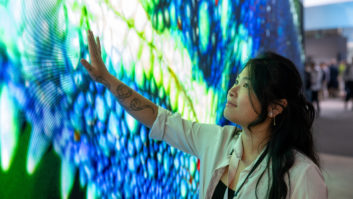 Perfectly aligned: how tough times can bring people together
Perfectly aligned: how tough times can bring people together
Broadcast manufacturing is built on innovation at its very core.
Traditionally, broadcast equipment has been a long-term investment, so broadcast R&D teams are never looking to build what broadcasters need now; they are constantly looking to design what they might need in three, five or ten years’ time.
But not even R&D teams with their own crystal ball department could have predicted what would happen over the last five years, and even before the world shifted on its axis the electronic manufacturing industry was already dealing with massive upheaval.
As far back as 2018, manufacturers were already feeling the pressure as semiconductor supply wobbled in the face of political trade wars and material shortages, and things only got worse with a succession of factory fires, monsoons and droughts which broke everything a little more.
Meanwhile, spiralling energy costs and massive political upheaval with both Brexit and the war in the Ukraine heaped on more misery, and a massive global pandemic right in the middle of it all didn’t help things at all.
But there is some good news; while all these things did create challenges for manufacturing, it also exposed many of its vulnerabilities. Meanwhile, sudden shifts in customer requirements and accelerated adoption of new production workflows helped inspire everyone, all at once.
We’ve never been ‘in it together’ more than we are now, and coming out the other side most suppliers are stronger because of it.
Planning
Throughout the Covid 19 pandemic, broadcasters remained on-air in a variety of ways, and it was the R&D departments of broadcast suppliers who kept them there. As viewing habits shifted from OTA to OTT content and necessity demanded remote and distributed production models, the manufacturing industry was there to help.
However, most suppliers were already dealing with their own challenges which the pandemic only amplified. With more electronics factories operating at reduced capacity due to Covid, lead times for components grew even longer and production bottlenecks became more common.
And as costs went up, components became scarcer still, having a profound effect on hardware manufacturers.

Marcus Brooke is the managing director of UK manufacturer Sonifex: “For a while it was like the Wild West. One chip increased in price from £43 to £3,030 in six months,” he says. “It was clear that our normal four-to-eight-week production window wasn’t long enough so we started weekly procurement meetings and increased our forward production window to load a full year of manufacturing into our system.
“We could see every component issue that we’d have in the next 52 weeks and we would sort out the issue in that meeting. It might mean sourcing from elsewhere, finding a different compatible part, or redesigning for another component to fit, but we’d decide as soon as we could what the way forward was going to be. We still have the meetings now, and we can cope with 99 per cent of shortages.”
With delivery times now back to normal, SSL’s general manager Enrique Perez says the company is also planning 12 months in advance, but its ability to quickly adapt its product range was essential in cushioning the blow.

“When you’re producing smaller MI products it is less of a problem, but when you are building a console which has perhaps 24 boards, all it takes is one missing part to affect all your production,” he says.
“Our timing was good as we had already been working on the SSL2 which came out at exactly the right time. It sold an insane number of units because musicians were staying at home and needed an interface. While the live market disappeared overnight, there was definitely a timing element with SSL in the home market, and that gave us a boost during that time.”
Decentralisation
Supply chain issues didn’t just affect UK manufacturing. With headquarters in Texas, USA, Brendon Mills, GM playout and networking for Imagine Communications, is hopeful that the market has learned from its mistakes.

“Historically, more than half of all chip fabrication facilities have been in Taiwan, but over the last few years, there have been a lot of really large FABs being built in the US,” he says. “There’s a global trend to ensure that we’re not caught out again, especially with some of the geopolitical tensions around China and Taiwan, and to try and alleviate some of those supply chain problems we have experienced.
“I think in the future there will be additional resiliency based on the decentralisation of fabrication and we are definitely seeing the manufacturing industry respond to some of the things we have experienced. It takes a lot of effort to normalise things, but things are aligning.”
Decentralising fabrication on a local level was also another element which provided support for SSL, which is part of the Audiotonix pro-audio group. “It made a huge difference,” according to Perez. “FPGAs are a good example because we share components with other brands in the group, and as a group we were able to access parts that we might not have had access to previously. I don’t think anybody across the group ever stopped production.”

For many manufacturers, the experience of the last few years has fundamentally changed how they approach their entire R&D processes. Luke Bradshaw is head of R&D at Sonifex: “It’s become a balancing act of assessing whether older products should be redesigned, modernised, or scrapped, in favour of working on new products,” he says.
“We have changed the way we look at designs. Historically we wouldn’t have had obsolescence in the forefront of our minds when thinking about new designs. Component lead times were fairly static, but this has changed massively since the pandemic.
“When designing new products, we now think about what we could do if they go obsolete, or lead times are pushed out, or if the price increases and makes the product unviable. We check if there are alternative part variants that will drop in place, and if not, we design alternative solutions that we can use. This sometimes means larger PCBs with increased design complexity, but it is something we need to do in an effort to mitigate expensive delays incurred during design re-spins and verification.”
Part two of this feature will be published on Friday this week.







